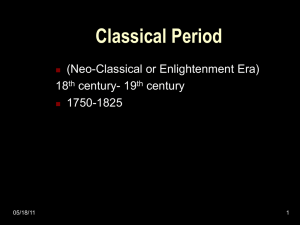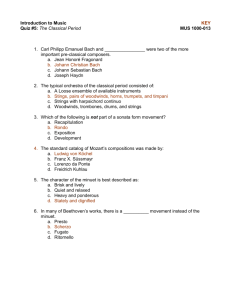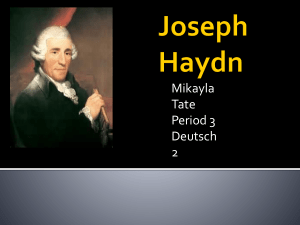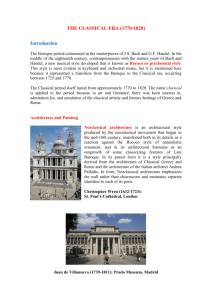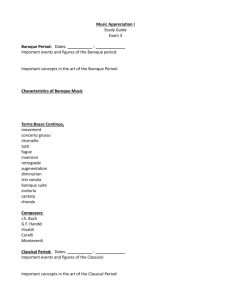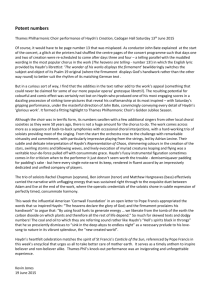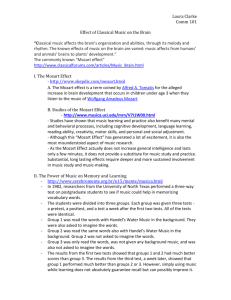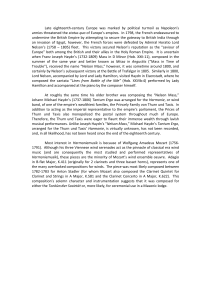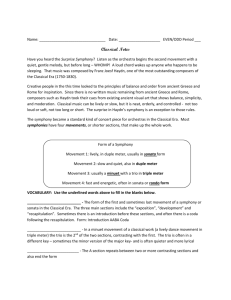Classical Music - Boston Philharmonic
advertisement
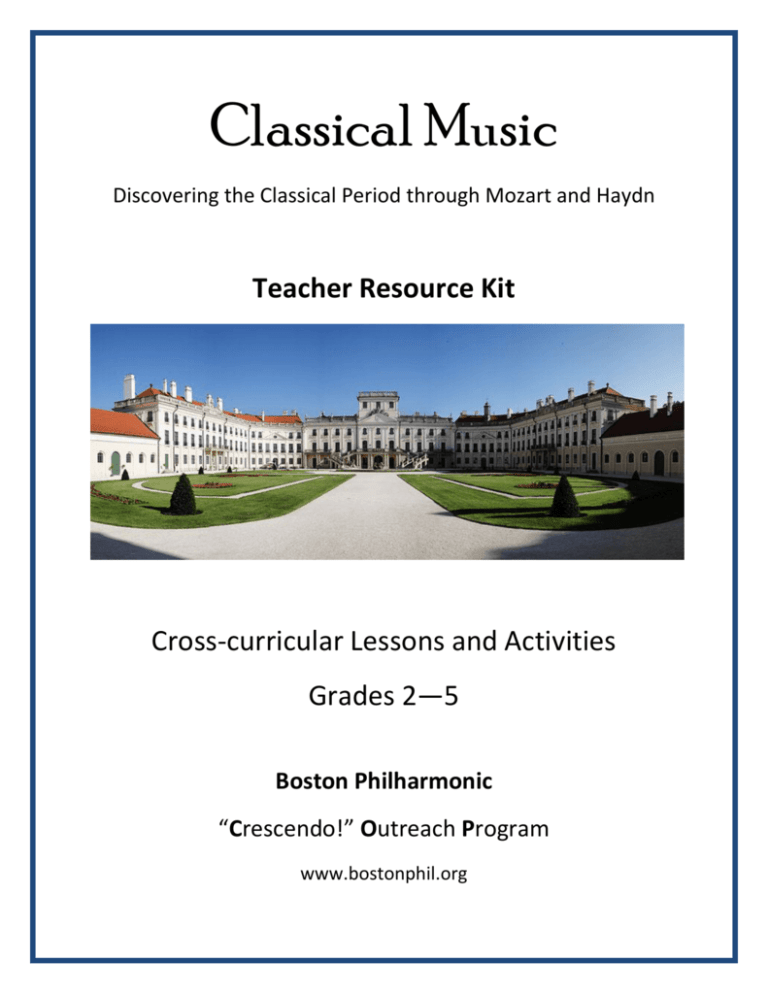
Classical Music Discovering the Classical Period through Mozart and Haydn Teacher Resource Kit Cross-curricular Lessons and Activities Grades 2—5 Boston Philharmonic “Crescendo!” Outreach Program www.bostonphil.org Dear Educator, The Boston Philharmonic believes that classical music can be enjoyed at any age, and it is never too early to begin learning. We are committed to providing opportunities and tools for our community, helping to create a personal connection to classical music. As part of our vision to make music accessible to everyone, we have developed guides and activities that will engage children and provide resources for teachers at a time when many public school districts are forced to cut music programs from the curriculum. Elementary school teachers can click on our study guides for activities to incorporate into their classrooms, or parents can explore the music together with their children. We hope you will enjoy learning more! Sincerely, The BPO “Crescendo!” Team Contributors to this study guide: Writer/Researcher/Designer: Alex Ray, Outreach Intern Editor : Pamela Feo, Outreach & Publications Manager Instrument Photos: Jeffrey Filiault, Multimedia Manager What is Classical? Classical refers to the art and architecture of ancient Greece and Rome. Beginning in Europe in the 1700s, people began to become interested again in the neat lines and orderly style that the Classical world was famous for. Buildings during this time often had columns and other decorations that reminded people of ancient Greece and Rome. Music during the Classical period became less decorative and complex than Baroque music, because composers were trying to imitate the simple and elegant Classical style that became popular in Europe during the Classical period. Here is one view of a palace in Austria where Haydn would have worked during the summer. What about the building reminds you of the Classical style? The outline of the building below is in the Classical style. Fill in the empty space with anything that reminds you of “Classical.” Use your imagination! Fun Fact: When he was young, Mozart often performed duets for European royalty with his sister, Nannerl. Wolfgang Amadeus Mozart (1756—1791) was a composer from Austria who lived during the Classical period. Mozart showed a talent for music from an early age, and was playing concerts for European royalty by the time he was six years old. Mozart composed music in just about every form that was in fashion while he was alive, and he remained a popular performer throughout most of his life. Mozart’s work had a great impact on classical music, and he influenced famous composers such as Ludwig van Beethoven. Mozart and Joseph Haydn also became friends, and Mozart dedicated six string quartets to Haydn in 1785. A quartet is a piece of music written to be performed by four instruments. Fun Fact: Haydn’s friends sometimes called him “Papa” Haydn. Although he didn’t have any kids, Haydn was known for being friendly and kind. Franz Joseph Haydn (1732—1809) was an Austrian composer during the Classical period. Haydn became involved with music at an early age, and got his start singing in a boys’ choir at St. Stephen’s Cathedral in Vienna. A choir is another name for a group of singers. By the time he was an adult, Haydn began working as a composer and conductor for the orchestra of the wealthy Eszterházy family in Hungary. Haydn continued to conduct and write symphonies in London, and he became very well known for his string quartets. Austria Facts Mozart and Haydn were both from Austria, which is a country located in Europe. The capital city of Austria is Vienna, an important city full of culture. About 8.5 million people live in Austria, which is about the same as the state of Virginia. Most people who live in Austria speak German. Austria shares its borders with 8 other countries, including Germany, Czech Republic, Hungary, Italy, and Switzerland. Traditional Austrian foods include schnitzel (meat dish) and strudel (pastry). Austria uses the Euro for its currency. Austria has a lot of mountains and is a popular place for skiing. The city of Innsbruck hosted the Winter Olympics in 1964 and 1976. Austria is shown on this map in dark green. The rest of Europe is light green. Mozart: Symphony No. 40 and Twelve Variations It is estimated that Mozart wrote about fifty symphonies, but his 40th Symphony is considered to be one of his best. Mozart wrote Symphony No. 40 in the summer of 1788 while living in Vienna, Austria. The piece uses 1 flute, 2 oboes, 2 clarinets, 2 bassoons, 2 French horns, and a full string section. Like most symphonies of the Classical period, Mozart’s 40th is divided into four sections, also called movements. Legend has it that Mozart never actually heard this symphony performed. But a close look at the letters that Mozart and other musicians wrote shows that he likely did attend at least one performance of Symphony No. 40. Here is an example of one of Mozart’s compositions, written in his own handwriting. An original copy of music like this is called an autograph. You might recognize the tune from Mozart’s Twelve Variations on Ah vous dirai-je, Maman, which is written for solo piano. Originally based on a French folk song, the melody, or main part of the song, is the same as the popular children’s tune Twinkle, Twinkle, Little Star, which was written later. The piece is called Variations, because Mozart uses the same basic pattern for the melody, but changes around the notes and rhythm each time, so that all twelve variations sound different. As you listen, see if you can still keep track of the original melody in your head during each variation. Joseph Haydn: The Joke and the “Farewell” Symphony No. 45 Haydn’s well-known sense of humor is put on display in his piece for string quartet known as The Joke. Written for 2 violins, 1 viola, and 1 cello, the work got its nickname because of the trick ending that Haydn came up with. The joke is that the piece seems to end many times: in the last movement, at several points the musicians become silent for a moment, but then suddenly continue to play. The audience is left unsure of when the piece will actually end. The story goes that at some of the early performances of The Joke, the audience would applaud at the wrong time or simply start laughing when they realized Haydn’s joke. This short and simple piece by Haydn is a good example of the elegant Classical style that was popular at the time. You can see how there are very few notes on the page in this autograph copy. Haydn’s Symphony No. 45, known as the Farewell Symphony, shows how Classical music, while often very serious, can also be lighthearted. Haydn wrote the piece in 1772 while staying with his orchestra at the Esterházy family’s palace in Hungary. Haydn worked for the Esterházy family and travelled with them, but Prince Nikolaus stayed at the palace for longer than expected and Haydn’s orchestra was anxious to return to their homes in Austria. To make a statement to the prince, at the end of the Farewell Symphony, Haydn told the musicians to leave the stage one by one, while the others kept playing until only a few were left. The prince got the message, and they all returned to Austria soon after. Classical Music Vocabulary Use the clues below to fill in the puzzle. All of the answers are words that were featured in bold in this study guide. You might have to look back to find the answers! The science behind the cello The cello is a string instrument, and it has four different strings that each plays a different note. Just like any other string instrument, the sound is made by making the strings vibrate. When something vibrates, it creates sound waves. Sound travels to our ears in the form of a wave. The vibration determines the shape of the wave, and how that wave is eventually heard by our ears. Different materials make different sound waves. In the case of the cello, the strings can be plucked by the player’s fingers, but most of the time the musician will move a bow across the strings to make the sound. The bow is a wooden rod with horsehair strung across its length. The horsehair is thin, but strong. When the bow glides across the strings of the cello as the musician plays, the horsehair touches the strings and causes them to vibrate in just the right way. Depending on where the musician puts his hand on the strings, different combinations of notes can be played. Here’s an activity that shows the relationship between sound and vibration. All you need is a few rubber bands and an empty metal coffee can. You can also try using an empty tissue box. To make your instrument, stretch the rubber bands around the coffee can or tissue box, across the opening. See if you can fit five or six rubber bands, leaving enough space between them so that each one can be plucked individually. The rubber bands are acting like the strings of a cello or the wires of a piano. When you pluck the rubber band, it vibrates and creates a sound. The sound waves bounce around inside the open space of the can or box, and then travel to your ears. Both the length and the thickness of the rubber band determine what the sound will be like. What do you notice about the different sounds that the rubber bands make? Experiment by using thin and thick rubber bands to make different sounds. What happens when you pull the rubber band tighter and then pluck it? MA Learning Standards (Grades 2—5) Covered in this Study Guide: ELA/Literacy, Speaking and Listening Standards 2. Ask and answer questions about key details in a text read aloud or information presented orally or through other media. Foreign Languages Cultures Strand 4.4 Identify distinctive cultural products from the target culture such as toys, clothes, foods, currencies, games, traditional crafts, and musical instruments Science and Technology/Engineering (Physical Sciences, Chemistry and Physics, Forms of Energy) 4. Identify the basic forms of energy (light, sound, heat, electrical, and magnetic). Recognize that energy is the ability to cause motion or create change. 4.11 Recognize that sound is produced by vibrating objects and requires a medium through which to travel. Relate the rate of vibration to the pitch of the sound. Technology/Engineering 1. Materials and Tools Central Concept: Appropriate materials, tools, and machines extend our ability to solve problems and invent. 1.1 Identify materials used to accomplish a design task based on a specific property, e.g., strength, hardness, and flexibility. Arts Critical Response 5.1 Perceive, describe, and respond to basic elements of music, including beat, tempo, rhythm, meter, pitch, melody, texture, dynamics, harmony, and form 5.2 Listen to and describe aural examples of music of various styles, genres, cultural and historical periods, identifying expressive qualities, instrumentation, and cultural and or/geographic context 5.3 Use appropriate terminology in describing music, musical notation, music instruments and voices, and music performances 5.4 Identify the sounds of a variety of instruments, including many orchestra and band instruments, and instruments from various cultures, as well as children’s voices and male and female adult voices 5.6 Describe and demonstrate audience skills of listening attentively and responding appropriately in classroom, rehearsal, and performance settings Observation, Abstraction, Invention, and Expression 3.2 Create 2D and 3D expressive artwork that explores abstraction 3.3 Create 2D and 3D artwork from memory or imagination to tell a story or embody an idea or fantasy Purposes and Meanings in the Arts 6.1 When viewing or listening to examples of visual arts, architecture, music, dance, storytelling, and theatre, ask and answer questions such as, “What is the artist trying to say?” “Who made this, and why?” “How does this work make me feel?” 6.2 Investigate uses and meanings of examples of the arts in children’s daily lives, homes, and communities Roles of Artists in Communities 7.1 Investigate how artists create their work; read about, view films about, or interview artists such as choreographers, dancers, composers, singers, instrumentalists, actors, storytellers, playwrights, illustrators, painters, sculptors, craftspeople, or architects 8.2 Identify the characteristic features of the visual arts of world civilizations such as styles of ancient Egypt and Africa, China, Mesopotamia, Greece, Rome, and the Medieval period in Europe Inventions, Technologies, and the Arts 9.1 When using art materials or handling and viewing artifacts or musical instruments, ask and answer questions such as “What is this made of?” “How does this instrument produce sound?” “Would I design this differently?” “Who first thought of making something like this?” Interdisciplinary Connections 10.1 Integrate knowledge of dance, music, theatre, and visual arts and apply the arts to learning other disciplines Suggested CDs: Mozart Symphonies 38 Through 41, Scottish Chamber Orchestra conducted by Sir Charles Mackerras (2008) Mozart: Piano Concertos K.467 & 537; Variations K.265, performed by Andre Previn (2009) Haydn: Symphonies: No. 45 in F# minor "Farewell " / No. 48 in C "Maria Theresa,” L’Estro Armonico conducted by Derek Solomons (1990) Haydn: String Quartets Op 33, Quatuor Mosaiques (2000) Image Credits Esterházy-kastély (4051. számú műemlék) 2.jpg http://upload.wikimedia.org/wikipedia/commons/9/9f/Esterh%C3%A1zykast%C3%A9ly_%284051._sz%C3%A1m%C3%BA_m%C5%B1eml%C3%A9k%29_2.jpg By Szvitek Péter (Indafotó) [CC-BY-2.5-hu (http://creativecommons.org/licenses/by/2.5/hu/deed.en)], via Wikimedia Commons Schlossesterhazyhinten.jpg http://upload.wikimedia.org/wikipedia/commons/a/aa/Schlossesterhazyhinten.jpg By Clemens (Own work) [CC-BY-SA-3.0-at (http://creativecommons.org/licenses/by-sa/3.0/at/deed.en)], via Wikimedia Commons Claudius II coin (colourised).png http://upload.wikimedia.org/wikipedia/commons/3/3b/Claudius_II_coin_%28colourised%29.png Classical Numismatic Group, Inc. http://www.cngcoins.com [GFDL (http://www.gnu.org/copyleft/fdl.html), CC-BY-SA-3.0 (http://creativecommons.org/licenses/bysa/3.0/), CC-BY-SA-2.5 (http://creativecommons.org/licenses/by-sa/2.5) or Public domain], via Wikimedia Commons Rubber bands - Colors - Studio photo 2011.jpg http://upload.wikimedia.org/wikipedia/commons/9/91/Rubber_bands_-_Colors__Studio_photo_2011.jpg By Bill Ebbesen (Own work) [CC-BY-SA-3.0 (http://creativecommons.org/licenses/by-sa/3.0)], via Wikimedia Commons
